B2.5 Add and subtract fractions, using appropriate strategies, in various contexts.
Skill: Adding and Subtracting Fractions in Various Contexts
Make Connections Between Operations on Whole Numbers and Operations on Fractions
By Grade 8, students have already developed a solid understanding of addition and subtraction. It is important to make connections between operations with whole numbers and operations with fractions. For example, adding 3 eighths and 2 eighths is the same as adding 3 candies and 2 candies. The unit fraction can help to bridge student understanding about operations with whole numbers to fractions. For example, by saying "3 one-eighths and 2 one-eighths". Only the notation is different and more complex.
Valuing Informal Procedures to Develop Strategies
It is important to value informal procedures, as they contribute to the development of number sense and operation sense. In situations that involve operations, many students use personal algorithms rather than procedures. For example, a student with good number sense could tackle the addition of \(\frac{7}{8}\) of a sandwich and \(\frac{4}{8}\) of another identical sandwich in this way: "I know that with \(\frac{7}{8}\) of a sandwich, I have \(\frac{1}{8}\) less than a whole sandwich. So if I add \(\frac{1}{8}\) to \(\frac{7}{8}\), I have a whole and I'm left with \(\frac{3}{8 }\) of the second sandwich. So altogether I have \(\frac{7}{8}\; + \;\frac{4}{8}\; = \;1\frac{3}{8}\) sandwiches. »
Fundamental Operations
Applying an operation on numbers has the effect of changing the quantities involved. It is very important that students understand this aspect of quantity when using addition, subtraction, multiplication and division. By Grade 8, students have had the opportunity to learn about these relationships with respect to whole numbers. They should understand that in addition, two quantities are put together and result in a new quantity. For subtraction, one quantity is taken away from another quantity to result in a new quantity. We can also recognize that we are looking for a difference between the two given quantities.
It takes a long time to build a sense of operations with fractions, as one must think about the numerators, denominators, and wholes involved. Students should be given the opportunity to work with concrete and visual (semi-concrete) models and develop a sense of the magnitude of results before moving on to operations involving symbolic representations.
According to the Ontario Curriculum, Grade 8 students should be adding and subtracting fractions, using appropriate strategies, in various contexts.
For addition and subtraction with like denominators, it is essentially the addition and subtraction of objects or quantities of the same kind.
For example, in \(\frac{3}{7}\; + \frac{2}{7}\; = \frac{5}{7}\), the addition simply represents 3 one sevenths + 2 one sevenths = 5 one sevenths, just as 3 apples + 2 apples = 5 apples. In this example, sevenths are counted in the same way as apples. We have 3 pieces of a certain size and 2 pieces of the same size, which gives 5 pieces of that size.
Adding fractions becomes more complex when the fractions have unlike denominators, since the pieces are not the same size and not the same kind.
Subtraction is treated the same way. For example, if I take 3 marbles out of a bag that contains 5 marbles, 2 marbles remain. Similarly, if I subtract 3 one-eighths from 5 one-eighths, I have 2 one-eighths left \(\frac{5}{8}\; - \frac{3}{8}\; = \frac{2}{8}\).
Adding two whole numbers increases both initial quantities, while subtracting two whole numbers decreases the initial quantity. It is important for students to understand that the same is true for adding and subtracting fractions.
This allows them to evaluate the reasonableness of some answers obtained from incorrect procedures. For example, a student who adds the numerators and denominators of \(\frac{2}{3}\; + \;\frac{1}{3}\) to obtain \(\frac{3}{6}\) should see that this answer, which is equal to \(\frac{1}{2}\), is less than one of the original fractions, \(\frac{2}{3}\).
Source: translated from Guide d'enseignement efficace des mathématiques de la 4e à la 6e année, Numération et sens du nombre, Fascicule 2, Fractions, p. 75-77.
Explore Operations Using Multiple Models
It is important for students to learn fraction-related concepts in a variety of situations using a variety of models such as area models, linear models, and set models. The same is true for learning operations on fractions.
Source: translated from Guide d'enseignement efficace des mathématiques de la 4e à la 6e année, Numération et sens du nombre, Fascicule 2, Fractions p. 76.
When working with fractions, the most important and sometimes the most difficult thing is to represent the whole correctly. With concrete or visual (semi-concrete) materials, the visual effect of addition and subtraction is enhanced. Drawing on their experiences with whole numbers and developing a sense of operation, students may recognize, for example, that adding two-thirds (\(\frac{2}{3}\)) to one-third (\(\frac{1}{3}\)] is three-thirds (\(\frac{3}{3}\)), or one whole.
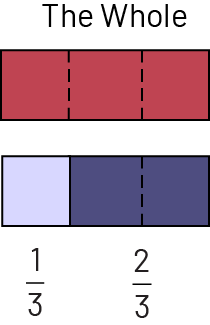
However, it is not always clear to students that addition is related to the numerator. In a situation where there are three eighths (\(\frac{3}{8}\)) left of a pizza and two eighths (\(\frac{2}{8}\)) left of another pizza of the same size, we look at how many are left in total. We are counting eighths, not sixteenths, even thought the pizzas had a total of 16 pieces.

Students progress to problems involving fractions with unlike denominators. Students can explore this type of problem in context using concrete representations and visuals.
For example, Alexis and his brother Mycolas each have a granola bar. The bars are identical. Alexis ate one third (\(\frac{1}{3}\)) of her granola bar and Mycolas ate three quarters (\(\frac{3}{4}\)) of his. How many granola bars do they have left altogether?
While this is a challenging situation for students, if they use benchmarks, a visualization of the situation, or a visual representation, they are able to conclude that there is almost a whole granola bar left.
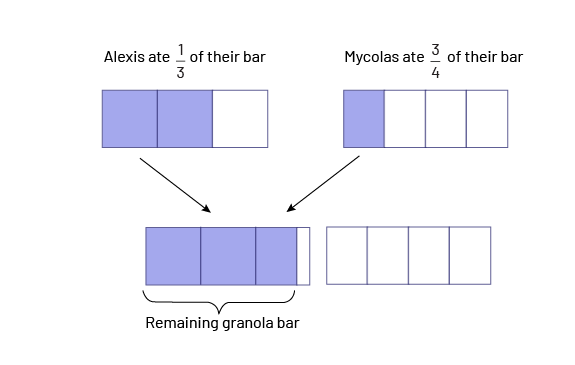
Here, this situation is represented with an area model. The rectangular shape is rather natural, since it looks like a granola bar. The granola bar is also a good choice of context because it is not already pre-divided into any number of fractional parts, so students can divide it into thirds or fourths, as needed to solve the problem. There are other representations, such as the linear model, that should not be overlooked.
The following example is about distance and uses mixed numbers:
As part of his training for a race, William must run at least \(6\frac{1}{{10}}\) km a day. This morning, before going to school, he ran \(3\frac{3}{{10}}\) km. How many kilometres does he have to run after school?
Since the situation deals with a linear measurement, students can use a linear model, such as a number line. The first step is to locate \(6\frac{1}{{10}}\) on a number line (left) or an open number line (right),

then subtract 3 from \(\ 6 \frac{1}{10}\).

then subtract the fractional part, \(\frac{3}{{10}}\).

Thus, we can conclude that William must run \(2\frac{8}{{10}}\) km. We therefore have \(6\frac{1}{{10}}\; - \;3\frac{3}{{10}}\; = \;2\frac{8}{{10}}\).
Although the linear model accurately represents the situation, students could represent the operation using an area model as shown below.
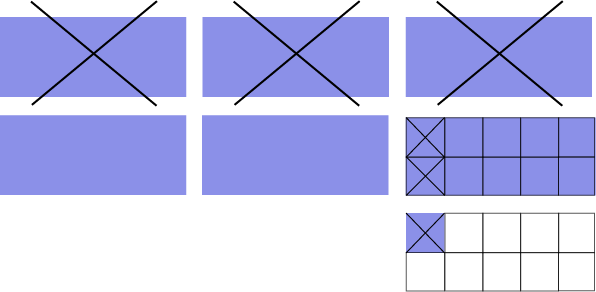
This situation can also be solved by decomposing \(6\frac{1}{{10}}\) into 5 wholes \(+ \;\frac{10}{10}\).
Now \(- \;3\frac{3}{{10}}\) can be subtracted, leaving \(2\frac{8}{{10 }}\).
Students should also explore situations involving improper fractions. For example, the operation \(\frac{{10}}{4} + \;\frac{3}{4}\) could be represented using the following model.

This model allows the result to be expressed as \(\frac{{13}}{4}\), if the fourths are counted, or \(3\frac{1}{4}\), as a mixed number.
Source: translated from Guide d'enseignement efficace des mathématiques de la 4e à la 6e année, Numération et sens du nombre, Fascicule 2, Fractions p. 92-94.
The following are examples of the different types of problems relating to addition and subtraction (joining problems, separating problems, comparing problems and part-part-whole problems).
Examples
Joining Problems
Mila ate \(\frac{2}{8}\) of a submarine sandwich, while Peter ate \(\frac{1}{2}\). What fraction of the submarine sandwich was eaten by the two children?
\(\frac{2}{8}\; + \;\frac{1}{2}\; = \;?\)
Representation using fraction strips:
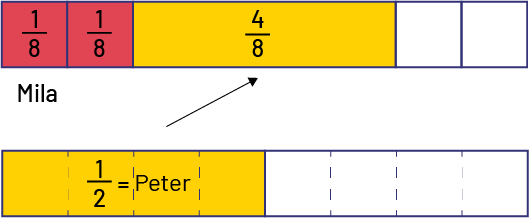
\(\begin{array}{l}\frac{2}{8}\; + \;\frac{1}{2}\; = \;\frac{2}{8}\; + \frac{ 4}{8}\;=\;\frac{6}{8}\\\frac{6}{8}\;=\;\frac{3}{4}\end{array}\)
\(\frac{6}{8}\;{\rm{or}}\;\frac{3}{4}\)of the submarine was eaten by the two children.
Source: Problem modified and translated from Guide d'enseignement efficace des mathématiques de la 4e à la 6e année, Numération et sens du nombre, Fascicule 2, Fractions p. 78.
The red ant is \(\frac{3}{{10}}\) cm long, the cicada is \(1\frac{1}{5}\) cm long, the beetle is \(\frac{2} {{10}}\) cm long and the ladybug is \(\frac{3}{{10}}\) cm long.
- Which improper fraction represents the total length of the insects in cm?
- What is this length in metres?
To add fractions, you need to represent them using like denominators. So, for the length of the cicada, I can find an equivalent fraction that has the same denominator as the other fractions. Or, I can use my understanding that each \(\frac{1} {{5}}\) is equivalent to \(\frac{2} {{10}}\), because one tenth is half the size of one fifth.
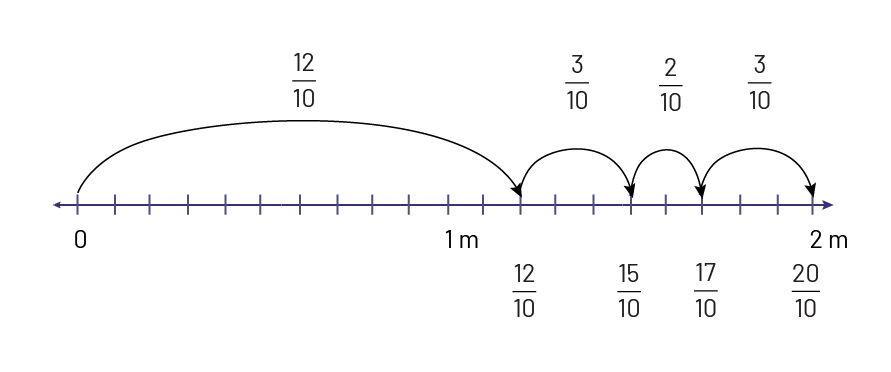
The total length is \(\frac{{20}}{{10}}\) cm or 2 cm. The total length in metres is \(\frac{2}{100}\) m or 0.02 m.
Source: adapted and translated from L'@telier - Ressources pédagogiques en ligne (atelier.on.ca).
Comparing Problem
Mila took \(\frac{1}{4}\) from a pitcher of water to water her plant. Peter took \(\frac{5}{8}\) from the pitcher to water his own. What fraction represents the difference between the amounts of water used by Peter and Mila?
Source: translated from Guide d'enseignement efficace des mathématiques de la 4e à la 6e année, Numération et sens du nombre, Fascicule 2, Fractions, p. 78.
To subtract fractions, you need to represent them using a common denominator. I can think of this a few different ways. So, for Mila's quantity of water, I found the equivalent fraction that has the same denominator as the other fraction representing Peter's quantity of water. Spatially, I know that one fourth is equivalent to two eighths. And I know that \(\frac{1}{4}\; = \;\frac{2}{8}\) since 8 is a multiple of 4. I multiply the denominator by 2 to get eighths, so I multiply the numerator by 2 too, to get \(\frac{2}{8}\).

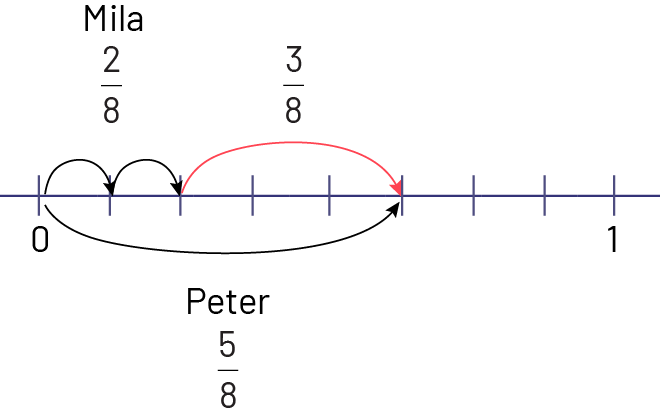
There is a difference of \(\frac{3}{8}\) of water from the pitchers.
Mental Math
In everyday life, students often encounter situations involving fraction operations, such as a store sale when items are offered at half price, or the headline in the newspaper that indicates enrollment in a college program has increased by one-third. In such situations, a mental calculation is often required. Depending on the context, either an estimation or an exact answer is appropriate.
Mental math is based on the use of relationships between numbers and operations. It requires flexibility in reasoning about the calculations to be performed. In mental math, numbers are often decomposed (for example, \(\frac{3}{4}\; = \;\frac{2}{4}\; + \;\frac{1}{4}\) or \(\frac{1}{2}\; + \;\frac{1}{4}\)) or recomposed.
(for example, \(\frac{1}{2}\; + \;\frac{3}{4}\; = \;1\frac{1}{2}\)) knowing that the 3 fourths are composed of 1 half and 1 fourth, the 2 halves are combined to make a whole, then 1 fourth is added.
Example
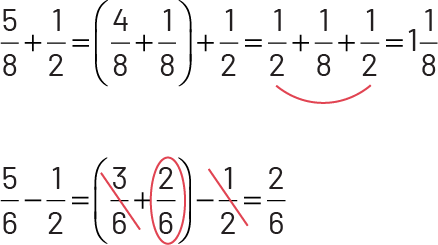
I know that \(\frac{3}{6}\) is equal to \(\frac{1}{2}\), so I decompose \(\frac{5}{6}\) into \(\frac{3}{6}\;+\;\frac{2}{6}\). I eliminated the \(2\frac{1}{2}\). I still have \(\frac{2}{6}\).
The fraction \(\frac{2}{6}\) can be simplified to \(\frac{1}{3}\).
Clearly, in order to mentally perform an operation with fractions, students must have a good understanding of fractions, operations, and operations with fractions.
Source: translated from Guide d'enseignement efficace des mathématiques de la 4e à la 6e année, Numération et sens du nombre, Fascicule 2, Fractions, p. 87.
Knowledge: Denominator
The number below the line in a fraction that represents the number of equal parts into which a whole or set is divided.
For example, the whole is a length.
\(\frac{2}{3}\) of the segment is red.
The denominator "3" of the fraction \(\frac{2}{3}\), represents the 3 equal partitions of the number line.

Knowledge: Numerator
The number above the line in a fraction that represents the number of equal parts being considered.
For example, the whole is a length.
\(\frac{2}{3}\) of the segment is red.
The numerator "2" of the fraction \(\frac{2}{3}\), represents the 2 red parts of the 3 equal partitions of the number line.

Knowledge: Equivalent Fractions
To recognize the equality of two fractions is to recognize that the two fractions represent the same quantity. According to Van de Walle and Folk (2005, pp. 236-237), we must distinguish between the concept of equivalent fractions and the algorithm for determining equivalent fractions.
Concept: Two fractions are equivalent if they represent the same quantity.
Algorithm: To obtain a fraction equivalent to any fraction, multiply or divide its numerator and its denominator by the same number (other than 0).
To determine equivalent fractions is to determine fractions that represent the same quantity. We then seek a number of “small parts” of a whole which correspond to a particular number of “large parts” of the same whole. For example, if we find the number of sixteenths that corresponds to a fourth (\(\frac{1}{4}\; = \;\frac{?}{{16}}\)):

Source: translated from Guide d'enseignement efficace des mathématiques de la 4e à la 6e année, Numération et sens du nombre, Fascicule 2, Fractions p. 50-51.
